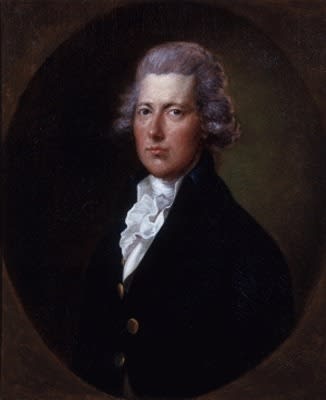
Gainsborough Dupont
Portrait of William Pitt the Younger (1759-1806), c. 1789
Oil on canvas
29 ½ x 24 ½ in. (75 x 62 cm)
Philip Mould & Co.
To view all current artworks for sale visit philipmould.com Gainsborough Dupont was born on 24th December 1754, the nephew of Thomas Gainsborough. He entered the Royal Academy schools in...
To view all current artworks for sale visit philipmould.com
Gainsborough Dupont was born on 24th December 1754, the nephew of Thomas Gainsborough. He entered the Royal Academy schools in 1774 but had been apprenticed to Gainsborough two years previously and remained his only assistant, producing studio replicas and scraping mezzotints of portraits and fancy pictures. Following his uncle's death he inherited his studio properties but failed to inherit Gainsborough's practice as a result of shyness and a lack of resolve rather than artistic merit. Ellis Waterhouse writes that ''his single heads, at his best, are in fact almost impossible to distinguish from the average run of his uncle's later portraits''.
Although this version was exhibited in Toronto in January 1932 as being by Gainsborough himself, the primary version of this composition of William Pitt as Lord Chancellor was last at auction in 1927, its current whereabouts unknown. Few of his aristocratic sitters merited mass reproduction, given their limited appeal outside the family, and whilst the Prime Minister later sat for Gainsborough Dupont himself (as did the Royal Family), his version of this early portrait would have been executed in response to the statesman's rising fame.
Born at Hayes in Kent on May 28th, 1759, as second son of William Pitt, Earl of Chatham, Pitt the Younger rose to great political eminence as both orator and statesman. He was educated at Pembroke Hall, Cambridge and became M.P. for Appleby in 1781 before being appointed Chancellor of the Exchequer the following year. By 1783 he had formed a new administration as Britain's youngest ever Prime Minister, winning an overwhelming majority at the General Election of 1784 and remaining in office for the next seventeen years.
Pitt's foreign policies, based on opposing France by means of European coalitions, imposed heavy financial burdens on the economy that were exacerbated by wars against the French. The growing strain forced the introduction of income tax in 1798, and the Irish rebellion of that year prompted the unification of the Irish and British Parliaments in 1800. By 1801 he was forced to resign his office in the face of intensifying economic and foreign problems and agreed to support Addington's administration, but on the resignation of that ministry in 1804, he re-entered office with a more vigorous policy. However, war disasters at Ulm and Austerlitz shattered his European coalition, and suffering a rapid deterioration of health he died on January 23rd, 1806. There is very little documentation of Pitt's sittings with Dupont, and the fact that the more famous images of the statesman in later life were executed by John Hoppner may indicate a shifting allegiance from Gainsborough's enhanced romanticism to the latter's realism as his health began to deteriorate.
Gainsborough Dupont was born on 24th December 1754, the nephew of Thomas Gainsborough. He entered the Royal Academy schools in 1774 but had been apprenticed to Gainsborough two years previously and remained his only assistant, producing studio replicas and scraping mezzotints of portraits and fancy pictures. Following his uncle's death he inherited his studio properties but failed to inherit Gainsborough's practice as a result of shyness and a lack of resolve rather than artistic merit. Ellis Waterhouse writes that ''his single heads, at his best, are in fact almost impossible to distinguish from the average run of his uncle's later portraits''.
Although this version was exhibited in Toronto in January 1932 as being by Gainsborough himself, the primary version of this composition of William Pitt as Lord Chancellor was last at auction in 1927, its current whereabouts unknown. Few of his aristocratic sitters merited mass reproduction, given their limited appeal outside the family, and whilst the Prime Minister later sat for Gainsborough Dupont himself (as did the Royal Family), his version of this early portrait would have been executed in response to the statesman's rising fame.
Born at Hayes in Kent on May 28th, 1759, as second son of William Pitt, Earl of Chatham, Pitt the Younger rose to great political eminence as both orator and statesman. He was educated at Pembroke Hall, Cambridge and became M.P. for Appleby in 1781 before being appointed Chancellor of the Exchequer the following year. By 1783 he had formed a new administration as Britain's youngest ever Prime Minister, winning an overwhelming majority at the General Election of 1784 and remaining in office for the next seventeen years.
Pitt's foreign policies, based on opposing France by means of European coalitions, imposed heavy financial burdens on the economy that were exacerbated by wars against the French. The growing strain forced the introduction of income tax in 1798, and the Irish rebellion of that year prompted the unification of the Irish and British Parliaments in 1800. By 1801 he was forced to resign his office in the face of intensifying economic and foreign problems and agreed to support Addington's administration, but on the resignation of that ministry in 1804, he re-entered office with a more vigorous policy. However, war disasters at Ulm and Austerlitz shattered his European coalition, and suffering a rapid deterioration of health he died on January 23rd, 1806. There is very little documentation of Pitt's sittings with Dupont, and the fact that the more famous images of the statesman in later life were executed by John Hoppner may indicate a shifting allegiance from Gainsborough's enhanced romanticism to the latter's realism as his health began to deteriorate.
Provenance
Anonymous sale, Christie's, 19th April 1963;R. Y. Eaton Collection, Toronto c. 1932
Literature
Walpole Society, vol. XXXIII1
of
2